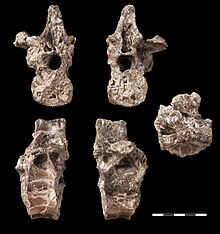Vectiraptor
| Vectiraptor | |
|---|---|

| |
| Camellate pneumaticity inside the dorsal vertebrae of Vectiraptor greeni | |
| Scientific classification | |
| Domain: | Eukaryota |
| Kingdom: | Animalia |
| Phylum: | Chordata |
| Clade: | Dinosauria |
| Clade: | Saurischia |
| Clade: | Theropoda |
| Family: | †Dromaeosauridae |
| Clade: | †Eudromaeosauria |
| Genus: | †Vectiraptor Longrich, Martill & Jacobs, 2021 |
| Species: | †V. greeni
|
| Binomial name | |
| †Vectiraptor greeni Longrich, Martill and Jacobs, 2021
| |
Vectiraptor (meaning "
Discovery and naming

Vectiraptor was initially discovered by amateur paleontologist Mick Green in 2004 in rocks of the
The
Of large and wide dromaeosaurid teeth previously reported from Wight, such as the specimens IWCMS.2002.1, IWCMS.2002.3, IWCMS.2002.4 and BMNH R 16510,[2] the describing authors considered it likely that they in fact belonged to Vectiraptor, though they were not formally referred.[1]
Description


The body length of Vectiraptor was estimated to be 2.5–3 metres (8.2–9.8 ft).[1]
The holotype includes two partial dorsal vertebrae and parts of the sacrum. Although fragmentary, the material shows a combination of features found only in the
Two
The vertebrae showed extensive pneumatisation. The dorsals had pleurocoels through which the air sacs of the respiratory system entered the vertebral bodies, forming large camellate air spaces. The diapophysal fossa also invaded the neural arch. The neural canals were expanded to behind, embaying the top of the centrum. The sacral vertebrae lacked pleurocoels and had a spongy bone structure. Their combined neural canal was so wide however, that it might have contained an air chamber, accessed by spaces between their partially fused neural arches.[1]
Phylogeny
A number of features, including the animal's large size, short dorsals, the presence of openings in the posterior dorsal vertebrae for
